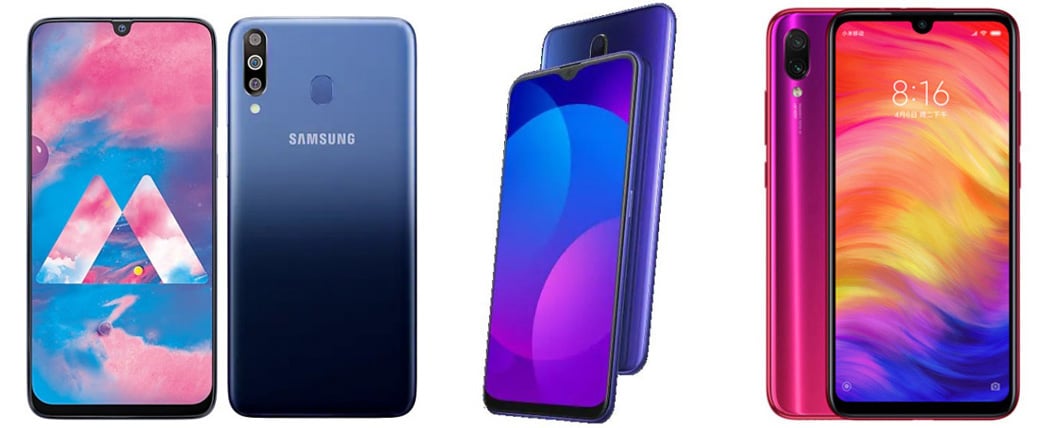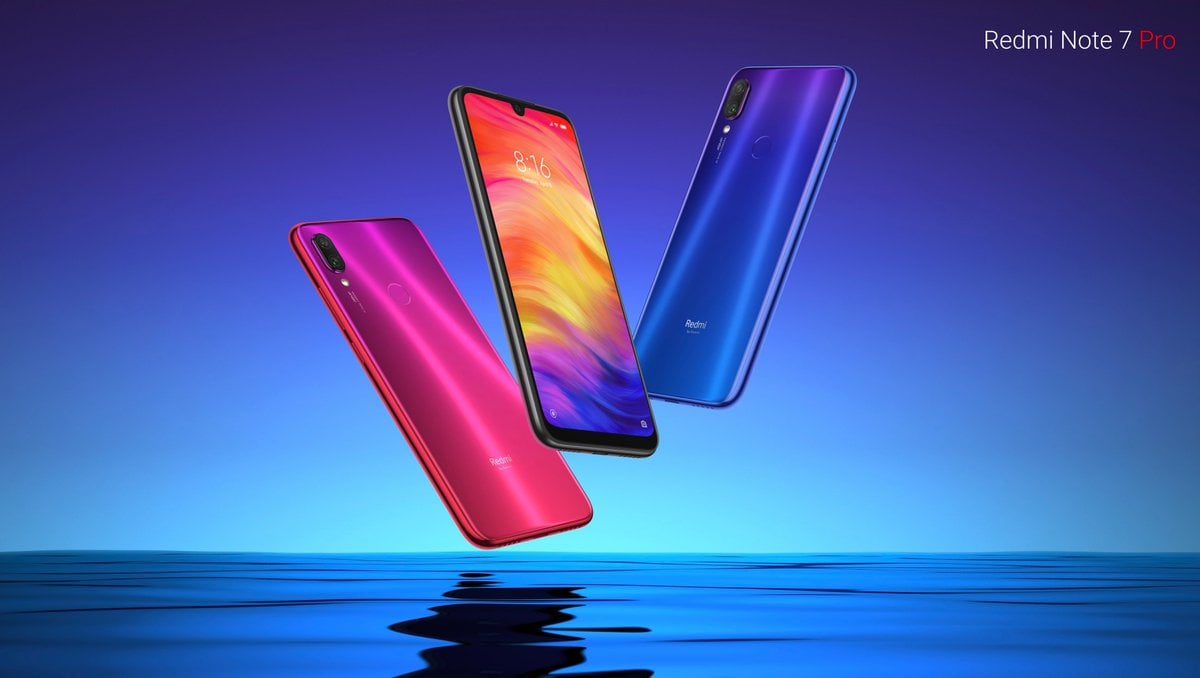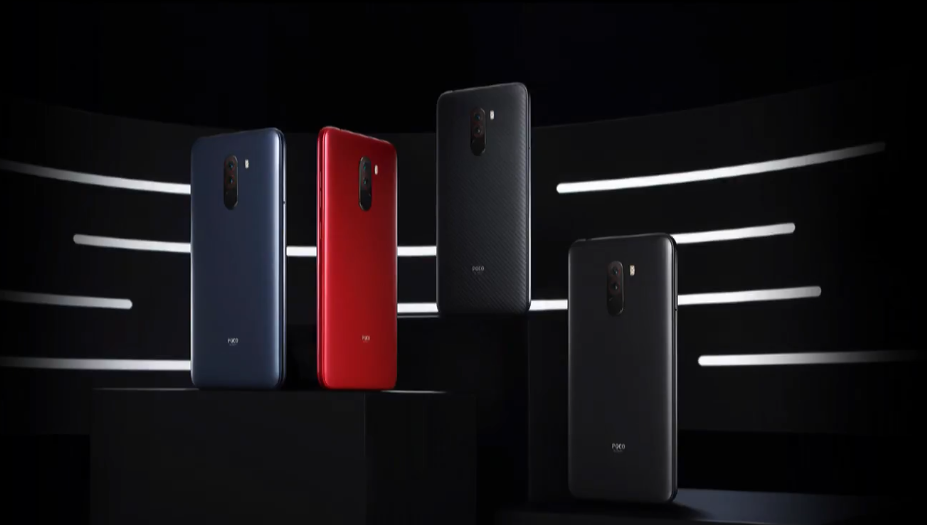Samsung just launched in India another midrange that will try to cannibalize the sales of its main Chinese concurrence. The Korean giant is struggling at keeping its market share in the midrange segment in the last years, but it does not stop trying. We are talking about the Galaxy M30 which combines a great price with a huge battery and an interesting camera department. In this comparison, the new mid-rangers challenges the Redmi Note 7 Pro that is expected to become one of the best-sellers of 2019 and the newly-announced Oppo F11. Did Samsung release a more interesting mid-ranger than the main Chinese ones? This comparison will help you find out.

Samsung Galaxy M30 vs Oppo F11 vs Xiaomi Redmi Note 7 Pro
| Samsung Galaxy M30 | Oppo F11 | Xiaomi Redmi Note 7 Pro | |
|---|---|---|---|
| DIMENSIONS AND WEIGHT | 159 x 75.1 x 8.4 mm | 161.3 x 76.1 x 8.8 mm, 190 grams | 159.2 x 75.2 x 8.1 mm, 186 grams |
| DISPLAY | 6.4 inches, 1080 x 2340p (Full HD+), 394 ppi, Super AMOLED | 6.53 inches, 1080 x 2340p (Full HD+), 395 ppi, LTPS IPS LCD | 6.3 inches, 1080 x 2340 pixels, 409 ppi, 19.5:9 ratio, IPS LCD |
| PROCESSOR | Samsung Exynos 7904, octa-core 1.8 GHz | MediaTek Helio P70, octa-core 2.1 GHz | Qualcomm Snapdragon 675, octa-core 2 GHz |
| MEMORY | 4 GB RAM, 64 GB – 6 GB RAM, 128 GB – micro SD slot | 4 GB RAM, 64 GB – 6 GB RAM, 128 GB | 4 GB RAM, 64 GB – 6 GB RAM, 128 GB – micro SD slot |
| SOFTWARE | Android 8.1 Oreo | Android 9 Pie, Color OS | Android 9 Pie, MIUI |
| CONNECTIVITY | Wi-Fi 802.11 a/b/g/n/ac, Bluetooth 5.0, GPS | Wi-Fi 802.11 a/b/g/n/ac, Bluetooth 5.0, GPS | Wi-Fi 802.11 a/b/g/n/ac, Bluetooth 5.0, GPS |
| CAMERA | Triple 13 + 5 + 5 MP f/1.9 and f/2.2 and f/2.2 16 MP f/2.0 front camera |
Dual 48 + 5 MP f/1.8 and f/2.4 16 MP f/2.0 front camera |
Dual 48 + 5 MP f/1.7 and f/2.4 13 MP front camera |
| BATTERY | 5000 mAh, fast charging 15W | 4000 mAh, fast charging with VOOC 3.0 | 4000 mAh, Fast Charging with Quick Charge 4 |
| ADDITIONAL FEATURES | Hybrid Dual SIM slot | Dual SIM slot | Hybrid Dual SIM slot |
Design
The design of the Samsung Galaxy M30 did not convince me so much, unlike its other specifications. The one I prefer more is the Redmi Note 7 Pro with its reflective glass back, pretty compact size and even good build quality. It is not among the most resistant phones out there, but it is water resistant, unlike most of the midrange devices. The reflective glass back can be chosen in stunning gradient color variants making it even more magnetic.
Display
We appreciated the fact that Samsung chose to use a Super AMOLED display even for a midrange from the M series. AMOLED panels provide more vivid colors and this particular one is very brilliant. While the quality of the display of Samsung Galaxy M30 attracts me, someone may prefer the Oppo F11 because it has a bigger and more phablet-like display. With a size of 6.53 inches, it is more suitable for advanced users and productivity. Even if you are a gamer you will find it more comfortable. Redmi Note 7 Pro has a classic midrange-class display which offers nothing exciting, so Samsung Galaxy M30 wins the display comparison.
Specs & Software
Thanks to the powerful Snapdragon 675 and its great GPU, Redmi Note 7 Pro is the king of performances here. It is the best device for you if you like gaming and multi-tasking, because its chipset is faster and it is very performing with high-demanding tasks. The second place should go to the 12 nm Helio P70 found on the Oppo F11. This device alongside the Redmi Note 7 Pro comes with Android 9 Pie out of the box, while Galaxy M30 is still based on Oreo. It does not make the difference as every device comes with a highly customized Android version, but it is good to know. Each of these devices comes in the same memory configurations, so the chipset makes the difference. Note that Oppo F11 has no expandable storage, unlike its rivals which come with a hybrid micro SD slot.
Camera
While Oppo F11 and Redmi Note 7 Pro are equipped with a rear dual camera composed of a main 48 MP sensor and a secondary depth sensor, Samsung Galaxy M30 opts for a triple camera including a 13 MP main sensor, a 5 MP ultrawide sensor and a depth sensor. Oppo F11 and Redmi Note 7 Pro should deliver a better photo quality, while Samsung Galaxy M30 will click more original shots thanks to its wide-angle sensor. Which one do you prefer? The front camera battle should be a hard fight between Samsung Galaxy M30 and Oppo F11. Note that we still did not test all the cameras of these devices, so we can not give you a definitive opinion about them. Despite its photo quality may be inferior, I would personally pick the Samsung Galaxy M30 for its ultrawide sensor. Mid-rangers are far away from flagships when it comes to camera quality, so I would focus on the innovation and original shots instead of camera quality when getting a midrange phone.
Battery
The battery of the Samsung Galaxy M30 is the biggest ones, even though Redmi Note 7 Pro and Oppo F11 are among the best battery phones in their segment. Thanks to its 1000 mAh more than its opponents and its efficient AMOLED display, the Galaxy M30 will surely provide a longer battery life. There should be no challenge and the Galaxy M30 should be able to last up to three days with a moderate usage pattern. Oppo F11 and Redmi Note 7 Pro should last more or less the same, but Redmi Note 7 Pro may offer something more due to its smaller display and its efficient Snapdragon 675 SoC.
Price
In the Asian market, you can get a unit of the Samsung Galaxy M30 or the Oppo F11 for about €250/$280 in the base configuration, while Redmi Note 7 Pro, that is the winner of this comparison because of its better chipset and a higher value for money, can be found at just €200/$225.
- Read More: Oppo F11 with MediaTek Helio P70 chipset and 4GB RAM announced in India for Rs. 19,990 ($283)
Samsung Galaxy M30 vs Oppo F11 vs Xiaomi Redmi Note 7 Pro: PROs and CONS
Xiaomi Redmi Note 7 Pro
PROs
- Better hardware
- Affordable price
- Great camera
- Big battery
CONS
- Nothing particular
Samsung Galaxy M30
PROs
- Bigger battery
- Nice display
- Good cameras
- High screen-to-body ratio
CONS
- Worse hardware
Oppo F11
PROs
- Bigger display
- Nice cameras
- Big battery
- Good hardware
CONS
- No micro SD slot







